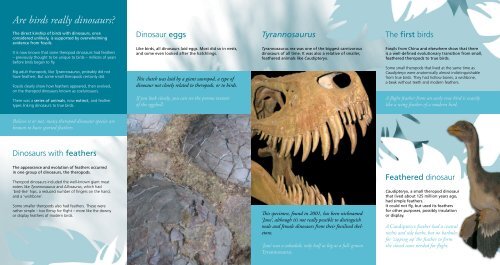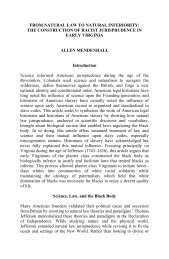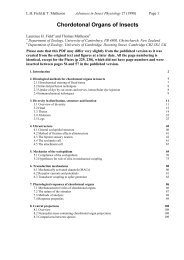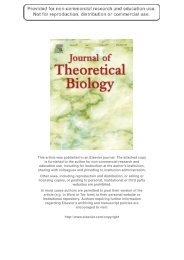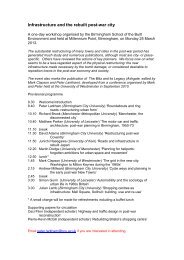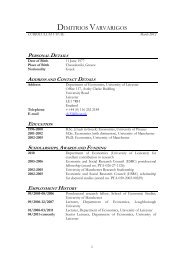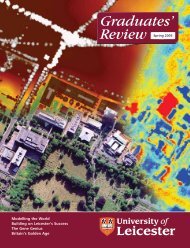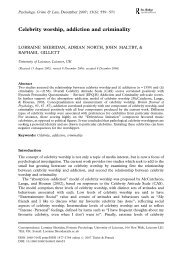Flying Dinosaurs Leaflet - University of Leicester
Flying Dinosaurs Leaflet - University of Leicester
Flying Dinosaurs Leaflet - University of Leicester
Create successful ePaper yourself
Turn your PDF publications into a flip-book with our unique Google optimized e-Paper software.
Are birds really dinosaurs<br />
The direct kinship <strong>of</strong> birds with dinosaurs, once<br />
considered unlikely, is supported by overwhelming<br />
evidence from fossils.<br />
It is now known that some theropod dinosaurs had feathers<br />
– previously thought to be unique to birds – millions <strong>of</strong> years<br />
before birds began to fly.<br />
Big adult theropods, like Tyrannosaurus, probably did not<br />
have feathers. But some small theropods certainly did.<br />
Fossils clearly show how feathers appeared, then evolved,<br />
on the theropod dinosaurs known as coelurosaurs.<br />
There was a series <strong>of</strong> animals, now extinct, and feather<br />
types linking dinosaurs to true birds.<br />
Dinosaur eggs<br />
Like birds, all dinosaurs laid eggs. Most did so in nests,<br />
and some even looked after the hatchlings.<br />
This clutch was laid by a giant sauropod, a type <strong>of</strong><br />
dinosaur not closely related to theropods, or to birds.<br />
If you look closely, you can see the porous texture<br />
<strong>of</strong> the eggshell.<br />
Tyrannosaurus<br />
Tyrannosaurus rex was one <strong>of</strong> the biggest carnivorous<br />
dinosaurs <strong>of</strong> all time. It was also a relative <strong>of</strong> smaller,<br />
feathered animals like Caudipteryx.<br />
The first birds<br />
Fossils from China and elsewhere show that there<br />
is a well-defined evolutionary transition from small,<br />
feathered theropods to true birds.<br />
Some small theropods that lived at the same time as<br />
Caudipteryx were anatomically almost indistinguishable<br />
from true birds. They had hollow bones, a wishbone, <br />
a beak without teeth and modern feathers.<br />
A flight feather from an early true bird is exactly<br />
like a wing feather <strong>of</strong> a modern bird.<br />
Believe it or not, many theropod dinosaur species are<br />
known to have sported feathers.<br />
<strong>Dinosaurs</strong> with feathers<br />
The appearance and evolution <strong>of</strong> feathers occurred<br />
in one group <strong>of</strong> dinosaurs, the theropods.<br />
Theropod dinosaurs included the well-known giant meat<br />
eaters like Tyrannosaurus and Allosaurus, which had<br />
‘bird-like’ hips, a reduced number <strong>of</strong> fingers on the hand,<br />
and a ‘wishbone’.<br />
Some smaller theropods also had feathers. These were<br />
rather simple – too flimsy for flight – more like the downy<br />
or display feathers <strong>of</strong> modern birds.<br />
This specimen, found in 2001, has been nicknamed<br />
‘Jane’, although it’s not really possible to distinguish<br />
male and female dinosaurs from their fossilised skeletons.<br />
‘Jane’ was a subadult, only half as big as a full-grown<br />
Tyrannosaurus.<br />
Feathered dinosaur<br />
Caudipteryx, a small theropod dinosaur<br />
that lived about 125 million years ago,<br />
had simple feathers.<br />
It could not fly, but used its feathers<br />
for other purposes, possibly insulation<br />
or display.<br />
A Caudipteryx feather had a central<br />
rachis and side barbs, but no barbules<br />
for ‘zipping up’ the feather to form<br />
the closed vane needed for flight.
Early bird<br />
Confuciusornis was one <strong>of</strong> the first true birds.<br />
It lived about 125 million years ago, alongside<br />
feathered dinosaurs like Caudipteryx, in what<br />
is now China. Feathers covered its body, as in<br />
modern birds, including contour feathers and<br />
flight feathers on its forelimbs, and it had a long<br />
tail – probably, as in modern birds, for display.<br />
Dinosaur phylogeny<br />
This family tree (cladogram) shows how the theropods<br />
are related to other dinosaurs.<br />
Birds are just one special group <strong>of</strong> theropods.<br />
Key facts<br />
about ‘Jane’, Tyrannosaurus rex<br />
• The fossil was found at Hell Creek in the arid badlands<br />
<strong>of</strong> Montana, in rocks <strong>of</strong> the Cretaceous Period that are<br />
about 66 million years old.<br />
• At that time the local environment was a lush,<br />
warm-temperate floodplain.<br />
• ‘Jane’ is a sub-adult: standing some 2.3 metres tall at<br />
the hip and 6.4 metres long, the dinosaur is about half the<br />
height and length <strong>of</strong> a full-grown T. rex.<br />
Department <strong>of</strong> Geology<br />
<strong>Flying</strong> dinosaurs<br />
...and the origin <strong>of</strong> birds<br />
• It is estimated that at the time <strong>of</strong> death ‘Jane’ was about<br />
11 years old and weighed nearly 700 kilograms (an<br />
adult T. rex weighed 5000 kilograms).<br />
• Its big feet and long powerful legs indicate that this type<br />
<strong>of</strong> dinosaur was built for speed and could possibly run<br />
as fast as 20-30 miles per hour.<br />
• Typical for a tyrannosaurid dinosaur, it has tiny forelimbs;<br />
the humerus bone is only about 28 centimetres long.<br />
• The lower jaw has many finely curved, razor-sharp teeth<br />
that were capable <strong>of</strong> tearing into flesh; it was a meat-eater.<br />
Department <strong>of</strong> Geology<br />
<strong>University</strong> <strong>of</strong> <strong>Leicester</strong><br />
<strong>University</strong> Road<br />
<strong>Leicester</strong><br />
LE1 7RH<br />
www.le.ac.uk/geology<br />
The exhibit was made possible by the generous<br />
sponsorship <strong>of</strong> Aggregate Industries UK Limited.


